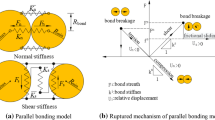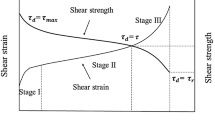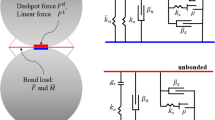Abstract
The distributed shear stress and the displacement across shear band, the evolution of plastic zones, and the load-carrying capacity of rock specimen were investigated in plane strain direct shear test according to Fast Lagrangian Analysis of Continua (FLAC). And then the shear displacement distribution in normal direction of system composed of localized shear band and elastic rock was analyzed based on gradient-dependent plasticity. The adopted failure criterion was a composite of Mohr-Coulomb criterion, that is, the relation between tension cut-off and post-peak constitutive of rock was linear strain-softening. Numerical results show that shear stress field approximately undergoes three different stages. At first, shear stress is only concentrated in the middle of top and base of specimen. Next, shear stress in the middle of specimen tends to increase, owing to superposition of shear stresses. Interestingly, two peaks of shear stress appear far from the loading ends of specimen, and the peaks approach with the increase in timestep until elements at the center of specimen yield. Finally, relatively lower shear stress level is reached in large part of specimen except in the regions near the two ends. As flow stress decreases, the analytical shear displacement distribution in shear band based on gradient-dependent plasticity becomes steep; outside the band, it is linear and its slope tends to decrease. These theoretical results qualitatively agree with that of the present numerical predicted results. Main advantage of the analytical solution over the numerical results according to FLAC is that it is continuous, smooth and non-linear (except at elastic stage).
Similar content being viewed by others
References
YIN You-quan, ZHANG Hong. The softening behaviour of fault zone medium and an instability model of earthquakes[J]. Acta Seismological Sinica, 1984, 6(2): 135–145. (in Chinese)
ZHANG Meng-tao. The instability theory and numerical simulation of rock burst[J]. Chin J Rock Mech Engrg, 1987, 6(3): 197–204. (in Chinese)
PAN Yi-shan, ZHANG Meng-tao, Li Guo-zheng. The study of chamber rockburst by the CUSP model of catastrophe theory[J]. Appl Math Mech (English Edition), 1994, 15(10): 943–951.
PAN Yue, LIU Ying, GU Shan-fa. Fold catastrophe model of mining fault rockburst[J]. Chin J Rock Mech Engrg, 2001, 20(1): 43–48. (In Chinese)
Vardoulakis I, Papanastasiou P. Bifurcation analysis of deep boreholes: I. Surface Instabilities [J]. Int J Num Anal Methods Geomech, 1988, 12: 379–399.
XIE He-ping, Pariseau W G. Fractal character and mechanism of rock bursts[J]. Chin J Rock Mech Engrg, 1993, 12(1): 28–37. (in Chinese)
FENG Tao, PAN Chang-liang. Lamination spallation bucking model for formation mechanism of rock burst [J]. Chin J Nonferrous Met, 2000, 10(2): 287–290. (in Chinese)
WANG Gui-yao, SUN Zong-qi, QING Du-gan. Fracture mechanics analysis of rock burst mechanism and prediction[J]. Chin J Nonferrous Met, 1999, 9(4): 841–845. (in Chinese)
TANG Li-zhong, PAN Chang-liang, WANG Wengxing. Surplus energy index for analyzing rock burst proneness[J]. J Cent South Univ Technol (Natural Science), 2002, 33(2): 129–132. (in Chinese)
YIN Guang-zhi, ZHANG Dong-ming, DAI Gao-fei, et al. Damage model of rock and the damage energy index of rockburst[J]. J Chongqing Univ, 2002, 25(9): 75–79. (in Chinese)
JI Hong-guang, WANG Jin-an, CAI Mei-feng. Relativity and unity physical and geometrical characteristics of rockbursting events[J]. J Chin Coal Soc, 2002, 28(1): 31–36. (in Chinese)
XU Lin-sheng, WANG Lan-sheng, LI Yong-lin. Study on mechanism and judgment of rockbursts[J]. Rock Soil Mech, 2002, 23 (3): 300–303. (in Chinese)
TANG Li-zhong, PAN Chang-liang, XIE Xue-bin, et al. Analysis and prediction of rock burst dangerous areas in Dongguashan Copper Mine under deep well ming[J]. J Cent South Univ Technol (Natural Science), 2002, 33(4): 335–338. (in Chinese)
QI Qing-xin, SHI Yuan-wei, LIU Tian-quan. Mechanism of instability caused by viscous sliding in rock burst[J]. J China Coal Soc, 1997, 22(2): 144–148. (in Chinese)
XU Ze-min, WU Pei-guan, WANG Su-da, et al. Analysis of energy released in process of rock burst[J]. J Natural Disasters, 2003, 12(3): 104–110. (in Chinese)
PAN Chang-liang, ZHU Fang-cai, CAO Ping, et al. Characteristics of acoustic emission of bursting-induced rocks under unaxial compression[J]. J Cent South Univ Technol(Natural Science), 2001, 32(4): 336–338. (in Chinese)
CAI Mei-feng, LAI Xing-ping. Study and application of monitoring for subsiding area in a composite hars rock roadway[J]. Chin J Rock Mech Engrg, 2003, 22(3): 391–394. (In Chinese)
PAN Li-you, JIANG Yu-jing, LI Xing-wei, et al. Dilation theory of rock burst[J]. Chin J Rock Mech Engrg, 2002, 22 (Supple): 2301–2303. (In Chinese)
WU Ai-xiang, SUN Ye-zhi, Gour S, et al. Characteristics of rockburst and its mining technology in mines[J]. J Cent South Univ Technol(English Edition), 2002, 9(4): 255–259.
CAI Mei-feng, WANG Jin-an, WANG Shuang-hong. Prediction of rock burst with deep mining excavation in Linglong Gold Mine[J]. J Univ Sci Technol Beijing, 2001, 8(4): 241–243.
LIU Jian-Xin, TANG Chun-an, ZHU Wan-cheng, et al. Rock-coal model for studying the rockburst[J]. Chin J Geotech Engrg, 2004, 26(2): 276–280. (In Chinese)
WANG Xue-bin, HAI Long, HUANG Mei. Quantitative calculation of dissipated energy of fault rock burst based on gradient-dependent plasticity [J]. J Univ Sci Technol Beijing, 2004, 11(3): 197–201.
WANG Xue-bin, PAN Yi-shan, MA Jin. Analysis of strain (or the ratio of strain) in the shear band and a criterion on instability based on the energy criterion [J]. Chin J Engrg Mech, 2003, 20(2): 111–115. (in Chinese)
WANG Xue-bin, YANG Xiao-bin, PAN Yi-shan. Dynamic analysis of fault rockburst based on gradient-dependent plasticity and energy criterion[J]. J Univ Sci Technol Beijing, 2004, 11(1): 5–9.
WANG Xue-bin. Analysis of progressive failure of pillar and instability criterion based on gradient-dependent plasticity[J]. J Cent South Univ Technol (English Edition), 2004, 11(4): 445–450.
WANG Xue-bin, PAN Yi-shan, MA Jin. Theoretical analysis of stability and unstable sliding of the system composed of shear band and elastic rock[J]. Chin J Geotech Engrg, 2002, 24(3): 360–363. (in Chinese)
WANG Xue-bin, PAN Yi-shan, HAI Long. Instability criterion of fault rock burst based on gradient-dependent plasticity [J]. Chin J Rock Mech Engrg, 2004, 23(4): 588–591. (in Chinese)
WANG Xue-bin, HUANG Mei, ZHAO Yang-feng, et al. Analysis on relation between snap-back of specimen and snap-back of system composed of direct shear testing machine and specimen[J]. Chin J Rock Mech Engrg, 2004, 23(3): 379–382. (in Chinese)
WANG Xue-bin, DAI Shu-hong, HAI Long, et al. Analysis of localized shear deformation of ductile metal based on gradient-dependent plasticity[J]. J Nonferrous Met Soc China, 2003, 13(6): 1348–1353.
WANG Xue-bin, YANG Mei, YU Hai-jun, et al. Localized shear deformation during shear band propagation in Titanium considering interactions among microstructures[J]. J Nonferrous Met Soc China, 2004, 14(2): 335–339.
WANG Xue-bin, PAN Yi-shan, SHENG Qian, et al. Simulation of triaxial compression and localization of deformation[J]. Rock Soil Mech, 2001, 22(3):323–326. (in Chinese)
WANG Xue-bin, PAN Yi-shan, SHENG Qian, et al. Numerical simulation of development of dynamic strain localization and size effect[J]. Chin J Comput Mech. 2002, 19(4): 500–503. (in Chinese)
WANG Xue-bin, PAN Yi-shan, DING Xiu-li, et al. Simulation of multiple shear bands in strain softening rock in plane strain[J]. Rock Soil Mech, 2002, 23(6): 717–720. (in Chinese)
WANG Xue-bin, PAN Yi-shan, SHENG Qian, et al. Numerical simulation of localized deformation field for rock in plane strain state[J]. Chin J Rock Mech Engrg, 2003, 22(4): 521–524. (in Chinese)
Author information
Authors and Affiliations
Corresponding author
Additional information
Foundation item: Project(50309004) supported by the National Natural Science Foundation of China
Rights and permissions
About this article
Cite this article
Wang, Xb. Shear stress distribution and characteristics of deformation for shear band-elastic body system at pre-peak and post-peak. J Cent. South Univ. Technol. 12, 611–617 (2005). https://doi.org/10.1007/s11771-005-0132-8
Received:
Accepted:
Published:
Issue Date:
DOI: https://doi.org/10.1007/s11771-005-0132-8
Key words
- shear stress
- shear displacement
- plane strain
- strain softening
- gradient-dependent plasticity
- shear band-elastic body system




